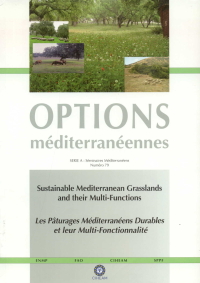| Article précédent | p. 463-469 | Article suivant |
The effect of mycorrhizal inoculation on forage and non-forage plant growth and nutrient uptake under field conditions
The effect of mycorrhizal inoculation on nitrogen fixing and non-fixing plant growth and macro- and micro-nutrient uptake were observed under field conditions. Several field experiments were set up on the research farm of Çukurova University (Eastern Mediterranean region). In one experiment clover, lentil, onion, garlic, chickpea and horse-bean plants were used. Cocktail mycorrhiza was used as a mycorrhizal strain. The results have shown, that in mycorrhizal plots, the yields of onion, garlic, chickpea, clover, lentil and horse-bean plants were higher than in non-mycorrhizal plants. Mycorrhizal inoculation also increased Cu and Zn content in the shoot. In another experiment carried out under field conditions for three successful years on horse-bean, chickpea and soybean plants, mycorrhizal inoculation was successfully applied in sterile and non-sterile soil conditions with and without phosphorous application. After a three-year evaluation it was found that under field conditions mycorrhizal inoculation significantly increased horse-bean, chickpea and soybean. Likewise, applying more P resulted in increased yield. Garlic, chickpea and horse-bean did not grow very well in fumigated plots compared to the non-fumigated ones. It was found that in fumigated plots mycorrhizal inoculation significantly increased growth of horse-bean and garlic. Mycorrhizal inoculation also increased nutrient uptake of both plants. Inoculation of the soil with mycorrhizae strains significantly increased plant growth and P uptake of plants, especially under low P supply. In low P application, plant roots were strongly infected and consequently increased plant growth, but with high P level applications there was a slight reduction in root infection. The results show that mycorrhizal inoculation is an effective practice for improving crop production in P-deficient soils.
L'effet de l'inoculation mycorhizienne sur la croissance des plantes fixatrices et non fixatrices d'azote et sur l'absorption de macro- et micro-nutriments a été observé en conditions de terrain. Plusieurs expérimentations de terrain ont été mises en place dans la ferme de recherches de l'Université de Çukurova (region méditerranéenne orientale). Dans une expérience, on a utilisé des plantes de trèfle, lentille, oignon, ail, pois chiche et fèverole. On a utilisé un mélange de mycorhizes comme souche mycorhizienne. Les réultats ont montré que, dans les parcelles mycorhiziennes, les rendements de l'oignon, ail, pois chiche, trèfle, lentille et fèverole, ont été supérieurs par rapport aux plantes non mycorhiziennes. L'inoculation mycorhizienne a également augmenté la teneur en Cu et Zn des pousses. Dans une autre expérience menée en conditions de terrain pendant trois années sur fèverole, pois chiche et soja, l'inoculation mycorhizienne a été appliquée avec succès en conditions de sol stériles et non stériles avec ou sans application de phosphore. Après une évaluation sur trois années, on a trouvé qu'en conditions de terrain l'inoculation mycorhizienne a donné une augmentation significative pour la fèverole, le pois chiche et le soja. De même, l'application de davantage de P a augmenté les résultats pour l'ail. L'ail, le pois chiche et la fèverole ne grandissaient pas très bien dans les parcelles sous fumigation par rapport aux parcelles non soumises à fumigation. On a trouvé que dans les parcelles sous fumigation l'inoculation mycorhizienne augmentait significativement la croissance de la fèverole et de l'ail. L'inoculation mycorhizienne augmentait également l'absorption de nutriments de ces deux plantes. L'inoculation du sol par des souches de mycorhizes augmentait significativement la croissance des plantes et l'absorption de P des plantes, en particulier sous faible apport de P. Avec une faible application de P, les racines des plantes étaient fortement infectées et par conséquent la croissance des plantes augmentait, mais avec des niveaux d'application de P élevés il y avait une lègère réduction de l'infection racinaire. Les résultats montrent que l'inoculation mycorhizienne est une pratique pour améliorer la production des cultures dans les sols présentant un déficit en P.
- [ Afficher ]
- [ Télécharger ]
- [ Exporter la citation ]
Vous pouvez télécharger la citation au format :
- [ Imprimer ]
-
Mots-clés
CROISSANCE, FIXATION DE L'AZOTE, MYCORHIZATION, RENDEMENT, SYMBIOSECiter cet article
Ortas I. The effect of mycorrhizal inoculation on forage and non-forage plant growth and nutrient uptake under field conditions. In : Porqueddu C. (ed.), Tavares de Sousa M.M. (ed.). Sustainable Mediterranean grasslands and their multi-functions . Zaragoza : CIHEAM / FAO / ENMP / SPPF, 2008. p. 463-469. (Options Méditerranéennes : Série A. Séminaires Méditerranéens; n. 79). 12. Meeting of the Sub-Network on Mediterranean Forage Resources of the FAO-CIHEAM Inter-regional Cooperative Research and Development Network on Pastures and Fodder Crop, 2008/04/09-12, Elvas (Portugal). http://om.ciheam.org/om/pdf/a79/00800698.pdf



